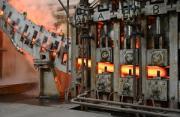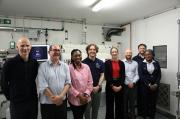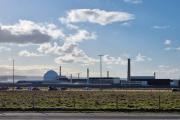Particles Could Be Cleaned Up Earlier Than Expected
3rd October 2007
The clean-up operation for radioactive particles offshore could be substantially complete within seven years while onshore monitoring with removal of detected particles would continue for a longer period if UKAEA's recommended way forward is accepted.
Following a review of all the information gained from public consultation, studies, test & trials, independent expert reports, improvements in the monitoring technologies and the knowledge gained by offshore mapping surveys, it is believed that an environmentally and publicly acceptable clean up could be achieved within this timescale.
Over the last two years UKAEA has conducted a public consultation programme and has, as the final stage, now come forward with a draft recommendation to implement particle removal from the offshore environment alongside monitoring onshore and recovery.
Over the next three summers, remotely-operated vehicle(s) would scour an area of seabed equivalent to 600,000m2 (60 football pitches) where the most hazardous particles are located. The fourth summer of monitoring and recovery will be integrated with the remediation of the old diffuser with a further three summers for re-checking and recovery. This area is almost certainly the source of particles found on local beaches and the progressive clean-up of this area should reduce and eventually eliminate the supply of the pollution to the beaches. Onshore monitoring and recovery would continue, until the seabed clean up has been demonstrated to be effective, at frequencies agreed with the Scottish Environment Protection Agency and the relevant landowner. The cost of monitoring and recovery both onshore and offshore over this seven year period has been estimated at in the region of �18-25million. Offshore trials of remote recovery equipment at the end of 2007, should allow this estimate to be
improved.
Sandside Estate which owns the affected Sandside Bay beach welcomes the UKAEA's draft recommendation.
Simon Middlemas, Dounreay Director said, "We have done an enormous amount of technical studies and have accumulated a huge amount of information which allows us to move forward to identify options which clearly, after extensive consultation, shows that this is an environmentally and publicly acceptable way forward. We have also been able to utilise recent offshore survey work and the information gained from enhanced beach surveys at Sandside into our recommendation. I would like to stress that this is a
preliminary recommendation and we have invited further public comment before we review and agree on how to take this forward with the key agencies and affected land owners"
Phil Cartwright, Contaminated Land and particles manager said "There is a far greater understanding of the extent of particle contamination now, monitoring systems are continually improving and we have a greater certainty of particle detection both on and offshore. In particular the co-operation of Sandside Estate and discussion with their experts, over the past 18 months, has aided this process.
"The recommendation is a broad strategy and the technical details will continue to be considered with the key agencies and stakeholders involved. Development of detection and recovery systems will continue, especially for the offshore environment.
"We do recognise that the removal of all particles from the environment is not going to be possible. Therefore the recovery strategy has to be considered in conjunction with the information on health effects in relation to particle activity ranges.
"There is a lot of historical information on particles and how they were released from Dounreay, as well as recent information on where the main concentrations of particles are now. The preliminary recommendation, identified from the best practical environmental option process, provides a good opportunity to move forward with something that is broadly acceptable to everyone. Following this final stage, of public comment, the important thing will be to get on with the clean-up and with the information gained, continue to look for further improvements to hasten the removal of large numbers of particles from the seabed. This is expected, within the next 10 years, to lead to lower numbers and lower activity particles being found on the local beaches where the majority of particles have been found, at Dounreay and at Sandside."
Geoffrey Minter of Sandside Estate commenting today said, "Co-operation between Dounreay and Sandside in recent times has permitted the exchange of detailed information. The recent seabed survey has for the first time proved the prediction that many more radioactive particles are on their way to Sandside which is the only publicly accessible beach where particles of relevance have and will continue to beach. It has also proved that something has to be done about the problem which will not go away by
itself.
"I am now confident that something will be done and there are clear signals that the issue is beginning to receive the attention it deserves. To that end I have today given UKAEA consent for the first in-depth survey and three dimensional mapping of Sandside beach which will be conducted in October. Following this, excavation work for which I have also given consent, can be conducted for the first time to reveal to us just what lies
in the Sandside sands below the surface that Ground Hog can reliably reach with its detectors. We both consider that this work should provide the last piece in the jigsaw puzzle of the particles at Sandside from which to move forward. I would stress that UKAEA's projected end dates are all subject to what is found along the way."
The final stage of the consultation allows members of the public to feedback their views which will be considered by UKAEA before producing their final recommendation to SEPA.
Related Businesses
Related Articles
UKAEA develops 3D printing for fusion components
At its recently opened Central Support Facility (CSF), UKAEA has commissioned an electron beam additive manufacturing machine that can be used to incorporate tungsten into components, alongside a selective laser manufacturing machine. Fusion can play a key role in a global low carbon energy future.Advancing Fusion Remote Maintenance: Industry Collaboration Driving Innovation
As part of the Fusion Futures (FF) programme, UKAEA's Remote Applications in Challenging Environments (RACE) has partnered with industry leaders to develop two groundbreaking technologies for remote maintenance in fusion energy engineering. Thanks to FF funding, industry has taken the lead in maturing UKAEA technology concepts—delivering real-world solutions that enhance operational autonomy and reduce maintenance burdens in extreme environments.UKAEA launches International Fellowships Scheme for fusion
UKAEA has launched the International Fellowships Scheme, an initiative to help expand the global talent pool supporting the fusion industry. The scheme is part of the UKAEA's Fusion Opportunities in Skills, Training, Education and Research (FOSTER) Programme, which aims to train, support, and empower the next generation of professionals, who will help deliver fusion power to the grid.Kyoto Fusioneering and Astral Systems join Culham fusion hub
UKAEA's Culham Campus welcomes Kyoto Fusioneering and Astral Systems as its latest tenants. Two pioneering companies, Kyoto Fusioneering and Astral Systems, have joined the growing cluster of fusion technology and AI organisations at United Kingdom Atomic Energy Authority's (UKAEA) Culham Campus.
Fusion-grade Steel Produced At Scale In UK-first
Researchers achieve 10x production cost savings for reduced activation steel. A United Kingdom Atomic Energy Authority (UKAEA) working group has successfully demonstrated the industrial scale production of fusion-grade steel.
UKAEA To Lead The Creation Of A Robotics And AI Cluster
UKAEA will lead the creation of a new £4.9m nuclear robotics and artificial intelligence cluster across Cumbria and Oxfordshire. The robotics and AI cluster was announced by UK Research and Innovation (UKRI) as one of seven new projects to kickstart economic growth and address regional needs: www.ukri.org The robotics and AI cluster will link Cumbria and Oxfordshire to accelerate the decommissioning of the UK's legacy nuclear fission facilities and keep people out of hazardous environments.
Diamonds Are Forever? World-first Carbon-14 Diamond Battery Made In Uk
The world's first carbon-14 diamond has been produced with the potential to provide power for thousands of years. Scientists and engineers from the UK Atomic Energy Authority (UKAEA) and the University of Bristol have successfully created the world's first carbon-14 diamond battery.
UKAEA Monthly Newsletter Latest Edition
Find out what has been happening at UKAEA in our monthly newsletter. Read about our recent activities and upcoming events.
UKAEA Newsletter - Edition 11 Published Today
Find out what has been happening at UKAEA in our monthly newsletter. Read about our recent activities and upcoming events.
Corwm Visits Dounreay Nuclear Site
Members were given an overview of the scale of the problem and challenges faced in the decommissioning of the site. In the last week of March 2024, several members of CoRWM led by the Chair, Sir Nigel Thrift, made the long journey up to the North of Scotland to visit the Dounreay nuclear site, now managed by Nuclear Restoration Services.
